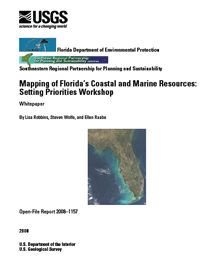Open-File Report 2008–1157
 PDF Open-File Report 2007-1257 |
Executive SummaryThe importance of mapping habitats and bioregions as a means to improve resource management has become increasingly clear. Large areas of the waters surrounding Florida are unmapped or incompletely mapped, possibly hindering proper management and good decisionmaking. Mapping of these ecosystems is among the top priorities identified by the Florida Oceans and Coastal Council in their Annual Science Research Plan. However, lack of prioritization among the coastal and marine areas and lack of coordination of agency efforts impede efficient, cost–effective mapping. A workshop on Mapping of Florida’s Coastal and Marine Resources was sponsored by the U.S. Geological Survey (USGS), Florida Department of Environmental Protection (FDEP), and Southeastern Regional Partnership for Planning and Sustainability (SERPPAS). The workshop was held at the USGS Florida Integrated Science Center (FISC) in St. Petersburg, FL, on February 7-8, 2007. The workshop was designed to provide State, Federal, university, and non-governmental organizations (NGOs) the opportunity to discuss their existing data coverage and create a prioritization of areas for new mapping data in Florida. Specific goals of the workshop were multifold, including to:
Over 90 invited participants representing more than 30 State and Federal agencies, universities, NGOs, and private industries played a large role in the success of this two-day workshop. State of Florida agency participants created a ranked priority order for mapping 13 different regions around Florida. The data needed for each of the 13 priority regions were outlined. A matrix considering State and Federal priorities was created, utilizing input from all agencies. The matrix showed overlapping interests of the entities and will allow for partnering and leveraging of resources. The five most basic mapping needs were determined to be bathymetry, high-vertical resolution coastline for sea-level rise scenarios, shoreline change, subsurface geology, and benthic habitats at sufficient scale. There was a clear convergence on the need to coordinate mapping activities around the state. Suggestions for coordination included:
There was general consensus on the need to adopt a single habitat classification system and a strategy to accommodate existing systems smoothly. Unresolved aspects of the systems warrant that a separate workshop would be needed to work out details. Participants recognized that the State priority list would necessarily be updated periodically. An annual review of priorities would facilitate information exchange, mapping activities updates, and re-allocation of funding among changing priorities. It was recognized that mapping of State waters would take billions of dollars and in light of tightening budgets there was need for processes that could be used to appropriate or leverage monies for mapping and reduce data-collection costs. Fourteen different avenues were explored. There was a clear consensus that the linking of public to private partnerships to support mapping was imperative, and ways to achieve this were discussed. For more information concerning the report, please contact the author. |
Suggested citation: Robbins, Lisa, Wolfe, Steven, and Raabe, Ellen, 2008, Mapping of Florida’s Coastal and Marine Resources: Setting Priorities Workshop: U.S. Geological Survey Open-File Report 2008-1157, 36 pages; St. Petersburg, FL.
This document is available online only in Portable Document Format (PDF); the latest version of Adobe Acrobat® Reader or similar software is required to view it. Download the latest version of Acrobat® Reader, free of charge or go to access.adobe.com for free tools that allow visually impaired users to read PDF files.